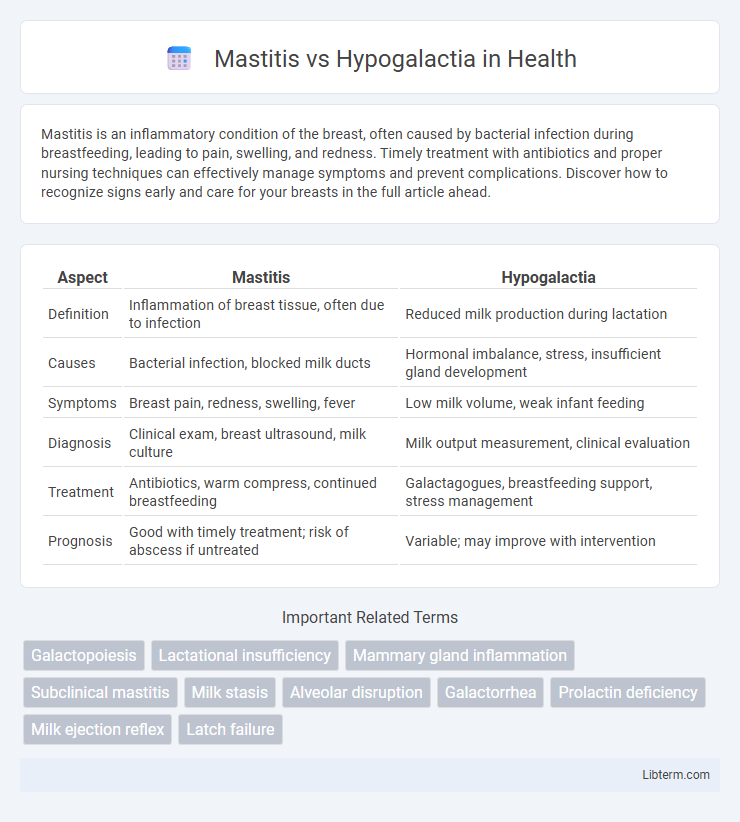Mastitis is an inflammatory condition of the breast, often caused by bacterial infection during breastfeeding, leading to pain, swelling, and redness. Timely treatment with antibiotics and proper nursing techniques can effectively manage symptoms and prevent complications. Discover how to recognize signs early and care for your breasts in the full article ahead.
Table of Comparison
| Aspect | Mastitis | Hypogalactia |
|---|---|---|
| Definition | Inflammation of breast tissue, often due to infection | Reduced milk production during lactation |
| Causes | Bacterial infection, blocked milk ducts | Hormonal imbalance, stress, insufficient gland development |
| Symptoms | Breast pain, redness, swelling, fever | Low milk volume, weak infant feeding |
| Diagnosis | Clinical exam, breast ultrasound, milk culture | Milk output measurement, clinical evaluation |
| Treatment | Antibiotics, warm compress, continued breastfeeding | Galactagogues, breastfeeding support, stress management |
| Prognosis | Good with timely treatment; risk of abscess if untreated | Variable; may improve with intervention |
Introduction to Mastitis and Hypogalactia
Mastitis is an inflammatory condition of the breast tissue commonly caused by bacterial infection, often affecting breastfeeding women and leading to pain, swelling, and redness. Hypogalactia refers to insufficient milk production during lactation, which can result from hormonal imbalances, insufficient glandular tissue, or improper breastfeeding techniques. Both conditions significantly impact maternal health and infant nutrition, requiring accurate diagnosis and targeted treatment to ensure effective breastfeeding support.
Definitions: What is Mastitis? What is Hypogalactia?
Mastitis is an inflammation of the breast tissue commonly caused by bacterial infection, leading to pain, swelling, redness, and sometimes fever. Hypogalactia refers to insufficient milk production in lactating women, resulting in inadequate milk supply for breastfeeding. Both conditions impact lactation but differ fundamentally, with mastitis involving infection and inflammation, while hypogalactia relates to milk production deficiency.
Causes of Mastitis vs Hypogalactia
Mastitis is primarily caused by bacterial infection entering through cracked nipples or milk ducts, often resulting from poor breastfeeding hygiene or engorgement. Hypogalactia, on the other hand, is mainly due to insufficient milk production caused by hormonal imbalances, inadequate glandular tissue, or frequent breastfeeding interruptions. While mastitis triggers inflammation and infection, hypogalactia relates to physiological or hormonal factors reducing milk supply.
Risk Factors and Predisposing Conditions
Mastitis risk factors include nipple trauma, blocked milk ducts, and prolonged breastfeeding intervals, often exacerbated by bacterial infection such as Staphylococcus aureus. Hypogalactia is commonly linked to hormonal imbalances, inadequate glandular tissue, and maternal stress or fatigue, which impair milk production. Both conditions are influenced by maternal factors like previous breast surgery, inadequate breastfeeding technique, and underlying health issues such as diabetes or immune suppression.
Signs and Symptoms Comparison
Mastitis typically presents with localized breast pain, redness, swelling, and warmth, often accompanied by fever and flu-like symptoms. Hypogalactia is characterized by insufficient milk production without signs of infection or inflammation, causing poor infant weight gain and persistent hunger. Differentiating these conditions hinges on the presence of infection-induced symptoms in mastitis versus the primarily functional insufficiency seen in hypogalactia.
Diagnostic Approaches and Key Differences
Mastitis diagnosis relies on clinical signs such as breast pain, redness, swelling, and systemic symptoms like fever, supported by microbiological culture of breast milk to identify bacterial infection. Hypogalactia is diagnosed primarily through assessment of insufficient milk output relative to infant demand, often using infant weight gain patterns and direct measurement of milk volume. Key differences include mastitis presenting with inflammatory symptoms and bacterial involvement, whereas hypogalactia involves inadequate milk production without infection or inflammation.
Treatment Strategies for Mastitis
Effective treatment strategies for mastitis primarily include the administration of targeted antibiotics to combat bacterial infections, analgesics to reduce pain and inflammation, and continued breastfeeding or milk expression to prevent milk stasis. Supportive measures such as warm compresses and adequate hydration enhance recovery and reduce symptoms. Prompt medical intervention is critical to prevent complications like abscess formation or chronic infection in lactating individuals.
Management Options for Hypogalactia
Management options for hypogalactia primarily include frequent breastfeeding or milk expression to stimulate milk production, alongside ensuring adequate maternal hydration and nutrition. Pharmacological interventions such as galactagogues like domperidone or metoclopramide may be prescribed to enhance lactation in resistant cases. Lactation consultant support and addressing underlying medical conditions also play critical roles in effective hypogalactia management.
Prevention Tips and Breastfeeding Support
Mastitis prevention relies on frequent breastfeeding or milk expression to avoid milk stasis, maintaining proper latch technique to reduce nipple trauma, and ensuring breast hygiene to prevent infections. Hypogalactia management involves adequate maternal hydration, balanced nutrition, and stress reduction to promote sufficient milk production, along with frequent breastfeeding or pumping to stimulate supply. Breastfeeding support from lactation consultants provides personalized guidance on effective latch, milk removal, and managing milk supply issues to enhance overall breastfeeding success.
When to Seek Medical Advice
Seek medical advice for mastitis if symptoms such as breast redness, swelling, pain, fever above 101degF, or flu-like symptoms persist beyond 24-48 hours despite home treatments. In cases of hypogalactia, consult a healthcare provider if there is insufficient breast milk production after proper latch and feeding techniques have been established, especially if the infant shows signs of poor weight gain or dehydration. Early intervention is crucial to prevent complications and ensure effective management of both mastitis and hypogalactia.
Mastitis Infographic

 libterm.com
libterm.com